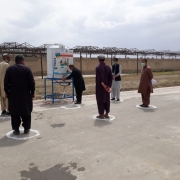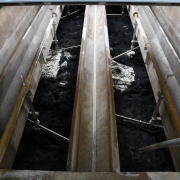Many Questions as Expert Committee Begins Study of Legionella in Plumbing
National Academy of Sciences, Engineering, and Medicine addresses risks from deadliest U.S. water disease.

Legionella bacteria thrive in warm, stagnant water. Reported cases of Legionnaires’ disease in the United States more than quadrupled between 2000 and 2015. Photo © J. Carl Ganter / Circle of Blue
By Brett Walton, Circle of Blue
Researchers, government officials, and technical experts met February 8 in Washington, D.C. for the first meeting of a National Academy of Sciences, Engineering, and Medicine investigation on minimizing the spread of Legionella bacteria in building plumbing and municipal water systems.
Legionnaires’ disease sickened at least 6,141 people in 2016 in the United States and killed several hundred, a death toll that is higher than any other water-related illness in the country. Yet there are more questions than answers about the pneumonia-like ailment, the bacteria that cause it, and the factors that lead to an infection.
Known for authoritative scientific reports that inform public policy, the Academy assembled a group of 13 experts with backgrounds in engineering, microbiology, infectious disease, water treatment, public health, and building management.
The range of specialties gives some indication of the complexity of the task at hand.
Typhoid or cholera it is not. Those water-borne disease are extremely rare or eliminated in the United States. But Legionnaires’ cases have increased more than four-fold in the last 15 years. The study aims to shed light on a disease that was first identified relatively recently, in 1976. Which of the roughly 60 strains of Legionella bacteria are most worrisome for human health? Can illness be diagnosed more quickly and accurately? Not contagious, the lung-targeting disease is spread by inhaling mist that carries Legionella bacteria. Several studies suggest that the number of reported cases is far lower than the number of infections.
For water systems, the committee will look at factors that increase the risk of Legionella growth. Within the building that means water temperature, water stagnation, plumbing design, disinfection, and age of pipes.
Some commenters urged the committee to concentrate on the contribution from municipal water systems. Street construction, water main breaks, or changes in water chemistry — as was the case in the Legionnaires’ outbreak in Flint in 2014 and 2015 — can catalyze bacteria growth or introduce contamination within the distribution system.
“We’re concerned that there is insufficient focus on the public water supply before it enters the building,” said Daryn Cline, director of science and technology for the Alliance to Prevent Legionnaires’ Disease.
Cline argued that Legionella management policies tend to respond to large-scale outbreaks. But these events account for only 4 percent of Legionnaires’ disease cases, according to the Centers for Disease Control and Prevention. The rest are individuals or cases in which the source of infection was not identified.
Above all, those responsible for managing buildings or overseeing regulations wanted practical advice from the committee for how to reduce risk and assess whether preventative actions are working, said Shantini Gamage of the Veterans Health Administration.
Gamage, noting that studies have found Legionella bacteria to be widespread in plumbing, wondered what guidelines managers should follow for testing locations and frequency, what concentration of bacteria should be concerning, and what responses a positive test should set in motion. “Is every building a ticking time bomb?” Gamage asked. “How do we know what to prioritize?”
Gamage also questioned lab testing reliability, recounting a time when her department sent the same water sample to four labs, which produced four different results. “Should we be acting when this is the testing result?” she asked.
The study, expected to take 18 months to complete, is sponsored by three federal agencies — Centers for Disease Control and Prevention, Environmental Protection Agency, Department of Veterans Affairs — and the Alfred P. Sloan Foundation, a philanthropic group with an interest in microbes in cities and buildings.
Brett writes about agriculture, energy, infrastructure, and the politics and economics of water in the United States. He also writes the Federal Water Tap, Circle of Blue’s weekly digest of U.S. government water news. He is the winner of two Society of Environmental Journalists reporting awards, one of the top honors in American environmental journalism: first place for explanatory reporting for a series on septic system pollution in the United States(2016) and third place for beat reporting in a small market (2014). He received the Sierra Club’s Distinguished Service Award in 2018. Brett lives in Seattle, where he hikes the mountains and bakes pies. Contact Brett Walton










